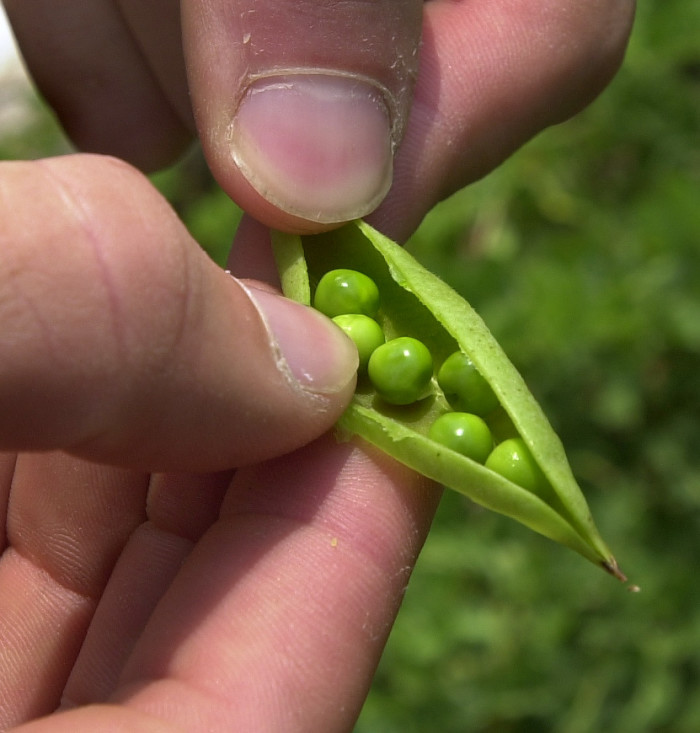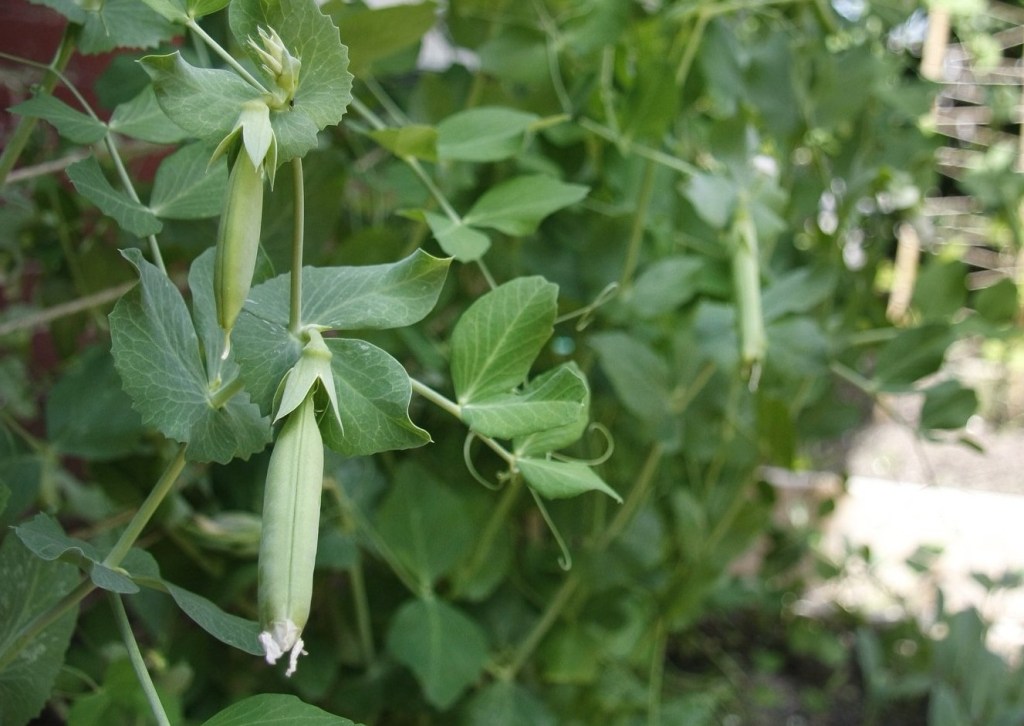Shelling peas, snow peas, snap peas.… Is anyone confused? What to grow, how to grow it, when to harvest it, how to prep it – I was confused, too. Especially once I began to grow peas in my own garden, because it’s not always easy to tell what you have on those beautiful vines if you plant without labeling things well in the spring, not that I’ve ever done that.
Of the three kinds of peas, the most well-known are shelling peas, which sometimes get called English peas or garden peas. Shelling peas – once they’ve been shelled – are the ones we most often see in the frozen food section of the grocery store. On the down side, their pods are tough and inedible. On the upside, they rank the highest of the three peas in calories and nutrients. These peas are ready to harvest when the shells have just become plump.
It’s best to pick every other day or so when they get going as the peas can quickly go from sweet and delicious to starchy and a little tough. To shell them, snap the top off and allow the string that remains connected to pull down or “unzip” the pod. Run your thumb or finger along the inside of the pod and let the peas fall into a bowl. This is a job that’s always much better with a partner. Much like with spinach, you always need far more than you think. A friend will stop you from eating as you go and help to move the process along. One pound of shelling peas yields about one cup of peas.
Snow peas are the flat peas that we usually see used in Asian foods. They are harvested early, before the peas develop into anything of note, and are used in their full pod form. Snow peas are never shelled, as their peas are just a shadow on the inside of the shell at the time of harvest.
When you cross a snow pea with a shelling pea, you get a sugar snap pea, the best of all worlds. Their pods are plump and crisp but edible, and the peas are sweet without having to shell them. These peas are best eaten raw or steamed just slightly. It’s a shame to overcook them, so err on the side of undercooking. These bright-green beauties can really steal the dinner-plate show when they’ve just been picked off the vine. To prep them, snap the tops off and then pull off the string on either side of the pod. Prepare them in any way that you would asparagus or green beans. Sugar snaps stay sweet longer than shelling peas, but the trade-off is a less complex “pea” flavor.
“Minding your peas” – shelling, snow and snap – is a late-spring and early-summer treat not to be missed. Peak season is June and July. All types can be stored in the refrigerator for a few days, but they are all best eaten the day you pick or bring them home.
Chinese Noodles with Snow Peas, Shiitakes, Cashews and Chicken
As with any stir-fry in the wok, prep all the ingredients ahead of time, since the cooking will go quickly. The noodles in this dish are typically available in the Asian food section of the grocery store and need little cooking time.
Serves 4 to 6
2 tablespoons canola or peanut oil
2 boneless chicken breast halves, cut into 1/4-inch slices (about 8 to 10 ounces)
5 ounces sliced shiitakes (about 3 cups)
1 tablespoon grated ginger
1 tablespoon minced garlic
4 cups low-sodium chicken broth
2 tablespoons soy sauce
1 teaspoon Chinese chili sauce
1 cup bean sprouts
14 ounces fresh Chinese-style noodles
4 cups snow peas, de-stemmed
1 cup cashews
Heat the oil over medium-high heat in a large wok. Add the chicken and stir-fry for 3 minutes. The chicken should not be done when you add the shiitakes. Add the shiitakes, ginger and garlic and stir-fry until the shiitakes begin to soften, about 2 minutes. Add the broth and tamari and bring to a boil. Add the remaining ingredients, except the cashews, and return to a boil.
Serve immediately in large bowls, topped with cashews.
Green Curry with Tofu and Snow Peas
Serves 4 to 6
1 (13.5-ounce) can coconut milk
2 ounces canned green curry paste
11/3 cup vegetable or chicken broth
1 tablespoon soy sauce
6 ounces snow peas (about 11/2 cups)
1 cup chopped green pepper (1/2-inch by 1-inch slices)
7 ounces extra-firm tofu, in 1/2-inch cubes
1/4 cup lightly packed, coarsely chopped basil
1/2 cup lightly packed, coarsely chopped cilantro
To serve:
1/3 cup sliced scallions
1/2 cup whole roasted unsalted cashews
Lime wedges from half of a lime
4 to 6 cups cooked jasmine rice
Bring the coconut milk, curry paste, broth and soy sauce to a boil in a medium sauce pan over medium-high heat. Turn the heat down and add the snow peas, green pepper, tofu, basil and most of the cilantro. Continue to cook about five minutes or until warmed through. Serve over rice with the scallions, cashews and lime.
Chicken à la King
It’s an oldie but goodie, best served over egg noodles or the way my grandma used to – over biscuits.
Serves 4 to 6
2 tablespoons butter
1/2 cup diced green pepper
1/2 cup diced carrot
1 cup diced onion
1 cup diced celery
2 pounds chicken breast, cut into 1/2-inch pieces
1 teaspoon kosher salt
1/4 cup flour
1 3/4 cup chicken broth
2 tablespoons diced roasted red pepper (or pimento)
2 cups sliced mushrooms
1 cup green peas
1/2 cup heavy cream
Melt the butter in a medium stock pot over medium-high heat. Add the peppers, carrots, onions and celery and sauté for 7 to 10 minutes or until they are soft and translucent. Add the chicken and salt. When the chicken is nearly cooked through, add the flour and mix well. Once the flour is fully incorporated, slowly add the broth, stirring to avoid lumps. Bring to a boil, then reduce to a simmer and cook the mixture for about 15 to 20 minutes. Add the red pepper, mushrooms, peas and heavy cream and bring to a boil once more. Remove from heat and serve immediately.
Anne Mahle is the chef aboard the Maine windjammer, Schooner J. & E. Riggin. Her latest cookbook is “Sugar and Salt: A Year at Home and at Sea.” She can be contacted at chefannie@mainewindjmmer.com
Send questions/comments to the editors.




Comments are no longer available on this story